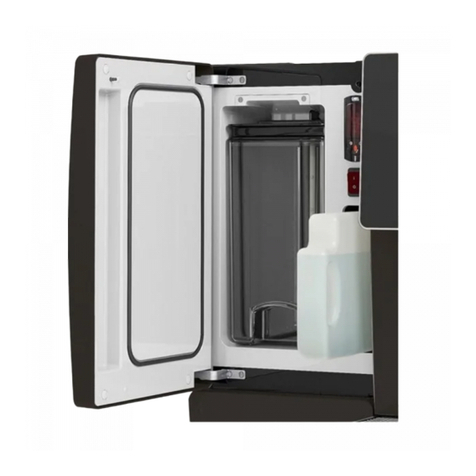Franke FMY 24 WCR User manual

FMY 24 WCR
EN Installation and user manual Wine cooler
DE Installations- und Gebrauchsanweisung Weinkühler
FR Manuel d‘installation et mode d‘emploi Cave à vin
NL Installatie- en gebruikershandleiding Wijnkoeler
IT Manuale per l‘installazione e l‘uso Cantinetta vino
ES Manual de instalación y servicio Refrigerador de vinos
PT Manual de instalação e de assistência Esfriador de vinho
EL Εγκατάσταση και εγχειρίδιο συντήρηση Ψύκτη κρασιών
CS Montážní a servisní návod Chladič vína
PL Instrukcja montażu iobsługi Chłodziarka do wina
RO Manual de instalare și service Vitrină frigorică pentru sticle de vin
SK Návod na inštaláciu a obsluhu Chladič vína
RU
UK
TR Kurulum ve servis kılavuzu Şarap soğutucusu
مﺪﺨﺘﺴﻤﻟا ﻞﻴﻟدو ﺖﻴﺒﺜﺘﻟا
AR
ﺬﻴﺒﻨﻟا دﱪﻣ


List of languages
EN Installation and user manual 5
DE Installations- und Gebrauchsanweisung 14
FR Manuel d‘installation et mode d‘emploi 23
NL Installatie- en gebruikershandleiding 32
IT Manuale per l‘installazione e l‘uso 41
ES Manual de instalación y servicio 50
PT Manual de instalação e de assistência 59
EL Εγκατάσταση και εγχειρίδιο συντήρηση 68
CS Montážní a servisní návod 77
PL Instrukcja montażu iobsługi 86
RO Manual de instalare și service 95
SK Návod na inštaláciu a obsluhu 104
RU 113
UK 122
TR Kurulum ve servis kılavuzu 131
AR مﺪﺨﺘﺴﻤﻟا ﻞﻴﻟدو ﺖﻴﺒﺜﺘﻟا 140


5
EN
Table of Contents
Safety information................................................................................................................................................................. 6
Installation..................................................................................................................................................................................9
Overview ................................................................................................................................................................................... 11
Operations............................................................................................................................................................................... 12
Cleaning and maintenance .............................................................................................................................................. 12
Troubleshooting .................................................................................................................................................................... 13
Support ..................................................................................................................................................................................... 13

6
Safety information Important to be read and observed
Before the installation and use of the
appliance, carefully read the supplied
instructions.
Always keep the instructions with the
appliance for future reference.
To prevent danger stemming from instability
of the device, you must fasten it in place,
following the assembly instructions strictly.
Whenever movingortransportingthedevice,
keep it in a vertical position.
This appliance can be used by children
aged from 8 years and above and persons
with reduced physical, sensory or mental
capabilities or lack of experience and
knowledge if they have been given
supervision or instruction concerning use of
the appliance in a safe way and understand
the hazards involved.
Children shall not play with the
appliance.
Cleaning and user maintenance shall
be made by the user and not by children
without supervision!
Young children should be supervised
to ensure that they do not play with the
appliance.
This appliance may be used by children
between 3 and 8 years of age and persons
with very extensive and complex disabilities,
if they have been properly instructed.
Children of less than 3 years of age
should be kept away from the appliance
unless continuously supervised.
Do not let children play with the
appliance.
Children shall not carry out cleaning
and user maintenance of the appliance
without supervision.
Keep all packaging away from children
and dispose of it appropriately.
This refrigerating appliance is intended
to be used at ambient temperatures ranging
from 16°C to 38°C.
Wait at least 4 hours before connecting
the appliance to the power supply.This is to
allow the oil to flow back in the compressor.
This appliance is not suitable for
freezing foodstus.
There is no dierence in consumption
between the possible conguration of the
shelves/basket.
WARNING: When positioning the
appliance, ensure the supply cord is not
trapped or damaged.
This appliance is intended to be used in
household and similar applications.
WARNING: Do not locate multiple
portable socket-outletsor portable power
supplies at the rear of the appliance.
After installing the device, ensure the
power cable and socket are easy to reach.If
it not possible to reach the power cable and
socket, ensure that the plug is connected to
a circuit breaker.
Keep the ventilation openings on the
casing of the device free.
Do not use mechanical devices, or any
means not suggested by the manufacturer,
to speed up defrosting.

7
EN
Do not damage the coolant circuit.
Contact the after sales service to
replace the LEDs.
Do not stare at operating lamp.It may
be harmful to the eyes.
The cable must not be bent or crushed.
Thecablemustbe checkedona routine
basis and replaced only by authorised
technicians.
The power supply cable is of a Y type.
Contact the after sales service to replace it.
Do not use electrical equipment inside
the wine compartments, unless they are of a
kind suggested by the manufacturer.
Do not store explosive substances
such as aerosol cans with aflammable
propellant in this appliance.
The Manufacturer shall not be liable if
any of the above rules are not complied with.
WARNING: Keep ventilation openings,
in the appliance enclosure or in the built-in
structure, clear of obstruction.
WARNING: Do not use mechanical
devices or other means to accelerate the
defrosting process, other than those
recommended by the manufacturer.
WARNING: Do not damage the
refrigerant circuit.
WARNING: Do not use electrical
appliances inside the wine compartment of
the appliance, unless they are of the type
recommended by the manufacturer.
Do not store explosive substances
such as aerosol cans with aflammable
propellant in this appliance.
Risk ofre and electrical shock orre.
Be careful not to cause damage to the
refrigerant circuit.It contains isobutane
(R600a), a natural gas with ahigh level of
environmental compatibility.This gas is
flammable.
If damage occurs to the refrigerant
circuit, make sure that there are noflame and
sources of ignition in the room.Ventilate the
room.
Do not let hot items to touch the plastic
parts of the appliance.
Do not storeflammable gas and liquid
in the appliance.
Do not putflammable products or
items that are wet withflammable products
in, near or on the appliance.
Do not touch the compressor or the
condenser. They are hot.
The device is a wine cooler.It is only
intended for storing wine.
Only store wine in unopened bottles.
The wine cooler is not suitable for
cooling foods.
Do not store any perishable food in the
wine cooler.
The fridge is not intended to be brought
into contact with food.
The fridge is not intended for the
storage of medicines.
NOTE: Condensating moisture on glass
doors.
When the ambient humidity is above 65 % in
25 °C ambient temperature, moisture will
condense on the glass door.

8
Disposal
The symbol on the product or on the
packaging indicates that the device must not
be disposed of in the domestic waste.
This appliance is manufactured with recyclable or reusable
materials.Dispose of it in accordance with local waste disposal
regulations.For further information on the treatment, recovery
and recycling of household electrical appliances, contact your
local authority, the collection service for household waste or
the store where you purchased the appliance.This appliance is
marked in compliance with European Directive 2012/19/EU,
Waste Electrical and Electronic Equipment (WEEE).
By ensuring this product is disposed of correctly, you will help
prevent negative consequences for the environment and
human health.
The symbol on the product or on the accompanying
documentation indicates that it should not be treated as
domestic waste but must be taken to an appropriate collection
center for the recycling of electrical and electronic equipment.
Package information
Packaging materials of the product are manufactured from
recyclable materials in accordance with our National
Environment Regulations.Do not dispose of the packaging
materials together with the domestic or other wastes.Take
them to the packaging material collection points designated
by the local authorities.
Energy saving tips
Do not open the door frequently or leave it open longer than
absolutely necessary.

9
EN
Installation
Positioning and connection
Installation, electrical connections and repairs must be carried
out by aqualied technician.
Unpacking
Unpack the device immediately and make sure it has not been
damaged during transport.Should it be damaged, do not
connect, and get in touch with the Dealer.
Carefully remove the protections and the adhesives, open the
door and make sure all the components are present.
Take out the power supply cable.
Positioning
Position the device in a well ventilated area, not damp and free
(avoid cabinets with closed walls).
Keep the device away from heat sources.
Make sure the minimum distances between the device and the
walls of the room where it is placed are kept, in order to ensure
perfect ventilation of the device.
See gure.
Wiring connection
After transport, stand the device vertically, and wait for at least
3 hours before connecting it to the wiring system.Before
putting the plug into the power socket, make sure that:
• the socket is earthed and according to legal regulations;
•the socket is able to hold up to the maximum power load of
the machine, indicated on the Data Sheet table or on the
feature plate to the bottom right (see Overview);
•the power supply voltage falls within the range indicated on
the Data Sheet table or on the feature plate to the bottom
right (see Overview);
•the power socket is compatible with the plug of the device.
Otherwise, replace the socket or the plug; do not use
extensions or multiple sockets.
Dimensions of the compartment
450 mm
min. 560 mm
min.
560 mm
Dimensions of
the cellar
Furniture side
area
Here, “Push to open”
Here, “Push to close”
444 mm
555 mm
24 mm
455 mm
560 mm
588 mm
Ventilation space:
at least 50 mm

10

11
EN
Overview
Control
panel
Leaf
glass
Bottle Ageing
Compartment Shelves Data plate
CONTROL PANEL
ON
Warning lamp
for light on
Light
Warning
lamp
for power
supply on
Display Reduce
temperature
Operation
warning lamp
Increase
temperature
ON/OFF
button

12
Operations
Bottle ageing compartment
Theageingcompartment‘smainfunctionisthatofguaranteeing
that your wines are preserved in optimal conditions.
The wine cellar‘s temperature was factory pre-set at 15° C, a
temperature that is considered optimal for most wines.
Wine has a complex nature and it derives from a long and slow
process. In order to best express its attributes, very specic
conditions are necessary.
All wines are preserved at the same temperature, but,
depending on their dierent characteristics, wines are served
and tasted at very dierent temperatures.
Therefore, just as for manufacturers‘ wine cellars, for your new
appliance, the absolute temperature value is not important for
preserving your wine.Rather, the constant temperature
through time is important.Wine preservation is ideal at any
temperature, as long as that temperature does not vary.
Manual temperature control
Should you need to adjust the temperature inside the wine
cellar, follow the instructions below:
•When you plug in your wine cellar, the display shows the
temperature that has been set.
•Press the button (see Control Panel) for one second.
Thetemperature will begin to blink.
•Press the or buttons until you reach the desired
temperature.
• Wait 5 seconds for the temperature to stop blinking.
•Wait until the wine cellar reaches its temperature before you
place the wine bottles inside.
The inside light does not go on (or it goes o temporarily) when
the inside temperature goes over 24° C. This allows you to
reach the pre-set temperature more quickly.
This appliance is intended to be used exclusively for the
storage of wine.
The appliance is recommended to be used at 18°C for the best
maintaining of red wine, 8°C for white wine or 12°C as an
average temperature for both red and white wine.The
temperature may be adjusted for wine that requires particular
maintaining temperature.
Normal operating sounds
The following sounds are normal during operation:
-A faint gurgling and bubbling sound from coils sound when
refrigerant is pumped.
-A whirring and pulsating sound from the compressor when
refrigerant is pumped.
-A sudden cracking noise from inside appliance caused by
thermic dilatation (a natural and not dangerous physical
phenomenon).
-A faint click noise from the temperature regulator when the
compressor switches on or o.
Stocking the wine bottles
Standard 24-bottle stock
The 24-bottle stock (for standard, mixed, and renana bottles) is
recommended for wines that need to be visible and easily
removed.
STANDARD
24 Bottles
(100% lying down)
3 shelves
Position each bottle into the slots on the 3 wooden shelves.
6 bottles can be placed on the bottom of the wine cooler.
We suggest placing the longer bottles (Rhine wine type) at the
cellar base.The base is suitable for hosting larger bottles.
Cleaning and maintenance
Regularly clean the inside and outside of the refrigerator using
only warm water and a neutral detergent.
Subsequent to washing, rinse with clean water and dry
thoroughly using a soft cloth.
Do not use the following: special glass and mirror cleaning
products, liquid, powder, or spray detergents, alcohol,
ammonia or abrasive products.
If you are not using the minibar, we suggest cleaning it well
inside and leaving the door ajar to ventilate the interior.
Before maintenance, deactivate the appliance and disconnect
the mains plug from the mains socket.
This appliance contains hydrocarbons in the cooling unit.Only
aqualied person must do the maintenance and the recharging
ofthe unit.
Regularly examine the drain of the appliance and if necessary,
clean it. Ifthe drain is blocked, defrosted water collects in the
bottom of the appliance.
The interior of the wine cooler should be cleaned regularly to
avoid odor.
Check the door gasket regularly to make sure there are no
debris.
Please turn o the power before cleaning.
Clean the inside surfaces with a warm water and baking soda
solution. The solution should be about 2tablespoons of baking
soda to a quart of water.
Rinse and dry thoroughly.

13
EN
Troubleshooting
If you notice that your wine cooler is not working properly,
check with the following list before you call your Service
Centre.
Problem Possible causes/Solutions
The compressor does not work
The plug is not plugged into the wall-outlet or not enough to make
contact. Or, there could be a power failure in your home.
The wall-outlet is not in working order. Plug the wine cellar into
another wall-outlet to check.
The compressor never stops Contact the Service Centre.
Any work that is done to the wine cellar should be performed
by your authorized local Service Centre.
Short term faults, such as power failure, will not compromise
the wines.It is only when working faults are left unsettled for a
long time that the wine may suer.
Support
In case of any operation problems, contact a Franke Technical
Service Centre.
Never use the services of unauthorised technicians.
When contacting our Service Centre, please state the codes
provided on your product‘s identication plate.
-the type of fault
-the appliance model (Art./Cod.)
-the serial number (S.N.)
This information is given on the data plate (see Overview).
You must also have proof of purchase if you are still within the
warranty period.
WWW.FRANKE.COM
©Franke Technology and Trademark Ltd., Switzerland

14
Inhaltsverzeichnis
Sicherheitshinweise ........................................................................................................................................................... 15
Installation................................................................................................................................................................................ 18
Übersicht................................................................................................................................................................................. 20
Funktionen............................................................................................................................................................................... 21
Reinigung und Pflege.......................................................................................................................................................... 21
Störungsbehebung............................................................................................................................................................. 22
Support .................................................................................................................................................................................... 22

15
DE
Sicherheitshinweise BITTE LESEN UND BEACHTEN
Lesen Sie vor der Installation und dem
Gebrauch des Geräts die mitgelieferte
Gebrauchsanweisung aufmerksam durch.
Bewahren Sie die Anweisungen stets
zusammen mit dem Gerät für den späteren
Gebrauch auf.
Befestigen Sie das Gerät ordnungsgemäß
laut Montageanleitung, um etwaigen
Gefahren durch Instabilität vorzubeugen.
Bewegen und transportieren Sie das Gerät
stets in senkrechter Position.
Dieses Gerät darf von Kindern ab 8
Jahren, von Personen mit eingeschränkten
körperlichen, sensorischen oder geistigen
Fähigkeiten sowie von Personen mit wenig
Erfahrung und Wissen zum Gerät bedient
werden, wenn sie zuvor in der sicheren
Nutzung des Geräts unterwiesen worden
sind und die damit verbundenen Gefahren
verstanden haben.
Kinder dürfen nicht mit dem Gerät
spielen.
Reinigung und Wartung sollte nur durch
den Nutzer selbst erfolgen; Kinder dürfen
dasGerätnurunterAufsichtvonErwachsenen
reinigen oder warten!
Kleinkinder sind zu beaufsichtigen, um
sicherzugehen, dass sie nicht mit dem Gerät
spielen.
DiesesGerätdarfvonKindernzwischen
3 und 8Jahren sowie von Personen mit
ausgeprägten und komplexen
Beeinträchtigungen bedient werden, wenn
sie zuvor ordnungsgemäß unterwiesen
worden sind.
Kinder unter 3 Jahren dürfen sich dem
Gerät nur unter Aufsicht nähern.
Lassen Sie Kinder nicht mit dem Gerät
spielen.
Kinder dürfen das Gerät nur unter
Aufsicht reinigen oder warten.
Halten Sie sämtliches
Verpackungsmaterial von Kindern fern und
entsorgen Sie es ordnungsgemäß.
Dieses Gerät ist für den Betrieb bei
Umgebungstemperaturen von 1 6 ° C bis 3 8 ° C
ausgelegt.
Warten Sie mindestens 4 Stunden,
bevor Sie das Gerät an die Stromversorgung
anschließen.Dadurch kann das Öl in den
Kompressor zurückfließen.
Dieses Gerät ist nicht zum Einfrieren
von Lebensmitteln geeignet.
Die Anordnung der Regale/des Korbs
kann beliebig gewählt werden und wirkt sich
nicht auf den Energieverbrauch aus.
ACHTUNG: Stellen Sie beim Aufstellen
des Geräts sicher, dass das Netzkabel nicht
eingeklemmt oder beschädigt ist.
Dieses Gerät ist für den
Haushaltsgebrauch sowie für ähnliche
Zwecke ausgelegt.
ACHTUNG: Versuchen Sie nicht, zu
denMehrfachsteckdosen oderNetzsteckern
auf der Hinterseite des Geräts zu gelangen.
Vergewissern Sie sich nach der
Installation des Geräts, dass Netzkabel und
Steckdose leicht erreichbar sind.Falls Sie
das Netzkabel und die Steckdose nicht
erreichen können, vergewissern Sie sich,
dass der Stecker an einen Schutzschalter
angeschlossen sind.

16
Halten Sie die Lüftungsschlitze am
Gehäuse des Geräts frei.
Verwenden Sie keine mechanischen
oder sonstige, vom Hersteller verbotene
Vorrichtungen, um das Abtauen zu
beschleunigen.
Beschädigen Sie den Kühlkreis nicht.
Kontaktieren Sie den Kundendienst,
wenn Sie die LEDs austauschen müssen.
StarrenSienichtaufdieBetriebsleuchte.
Andernfalls könnte dies Ihre Augen
schädigen.
Das Kabel darf nicht verbogen oder
gequetscht werden.
Das Kabel ist regelmäßig zu prüfen und
darf nur von autorisierten Technikern
ausgetauscht werden.
Das Netzkabel ist vom Typ Y.
Kontaktieren Sie den Kundendienst, wenn
Sie es austauschen müssen.
Verwenden Sie ausschließlich
elektrische Vorrichtungen im Inneren der
Lebensmittelfächer, die vom Hersteller
empfohlen werden.
Bewahren Sie keine explosiven
Substanzen wie Sprühdosen mit
entflammbarem Treibgas in diesem Gerät
auf.
Bei Nichteinhaltung der obigen
Vorschriften übernimmt der Hersteller
keinerlei Haftung.
ACHTUNG: Stellen Sie sicher, dass
Lüftungsschlitze in der Geräteeinfassung
oder der Einbaustruktur nicht verstopft sind.
ACHTUNG: Verwenden Sie keine
mechanischen Vorrichtungen oder sonstige,
vom Hersteller verbotene Mittel, um den
Abtauvorgang zu beschleunigen.
ACHTUNG: Beschädigen Sie den
Kühlkreis nicht.
ACHTUNG: Verwenden Sie
ausschließlich elektrische Vorrichtungen im
Inneren der Weinlagerungsfächer des
Geräts, die vom Hersteller empfohlen
werden.
Bewahren Sie keine explosiven
Substanzen wie Sprühdosen mit
entflammbarem Treibgas in diesem Gerät
auf.
Brand- und Stromschlaggefahr.
Achten Sie darauf, den Kühlkreis nicht
zu beschädigen.Er beinhaltet Isobutan
(R600a), ein Erdgas mit niedrigem
Treibhauseekt. Dieses Gas ist entflammbar.
SolltenSchädenamKühlkreisauftreten,
stellen Sie sicher, dass weder Flammen noch
andere Zündquellen im Raum vorhanden
sind.Lüften Sie den Raum.
Heiße Gegenstände dürfen die
Plastikteile des Geräts nicht berühren.
Lagern Sie keine brennbaren Gase und
Flüssigkeiten im Gerät.
Stellen Sie weder entflammbare
Produkte noch nasse Gegenstände in, auf
oder neben das Gerät.
Berühren Sie den Kompressor oder
Kondensator nicht.Diese Bauteile sind heiß.
Beim Gerät handelt es sich um einen
Weinkühler.Er ist ausschließlich für die
Lagerung von Wein vorgesehen.
Lagern Sie Wein ausschließlich in
ungeöneten Flaschen ein.

17
DE
Der Weinkühler eignet sich nicht zum
Kühlen von Lebensmitteln.
Lagern Sie keine leicht verderblichen
Lebensmittel im Weinkühler.
Der Kühlschrank ist nicht für
Lebensmittel ausgelegt und sollte daher
auch nicht mit diesen in Kontakt kommen.
Der Kühlschrank ist nicht für die
Lagerung von Medikamenten ausgelegt.
HINWEIS: Kondensierende Feuchtigkeit
auf Glastüren.
Bei einer Umgebungsfeuchtigkeit von über
65 % und 25°C Umgebungstemperatur
kondensiert Feuchtigkeit an der Glastür.
Entsorgung
Das Symbol am Produkt oder auf der
Verpackung weist darauf hin, dass das Gerät
nicht als normaler Hausmüll entsorgt werden
darf.
Dieses Gerät wurde aus recyclingfähigen oder
wiederverwertbaren Materialien hergestellt.Entsorgen Sie es
gemäß den lokalen Vorschriften der Müllentsorgung.Wenden
Sie sich an Ihre lokale Behörde, das Hausmüll-
Entsorgungsunternehmen oder das Geschäft, in dem Sie das
Gerät gekauft haben, um nähere Informationen über die
Behandlung, Verwertung und das Recycling von elektrischen
Haushaltsgeräten einzuholen.Dieses Gerät wurde
entsprechend der europäischen Richtlinie 2012/19/EU über
Elektro- und Elektronik-Altgeräte gekennzeichnet.
Durch ordnungsgemäße Entsorgung dieses Geräts leisten Sie
einen wichtigen Beitrag zum Umweltschutz und zur
menschlichen Gesundheit.
Das Symbol am Produkt oder auf der beigefügten
Dokumentation weist darauf hin, dass es nicht mit dem
Hausmüll, sondern nur in einem geeigneten Sammel- und
Recyclingzentrum für Elektro- und Elektronikgeräte entsorgt
werden darf.
Verpackungsinformationen
Die Verpackungsmaterialien dieses Produkts wurden aus
recycelbaren Materialien entsprechend unserer nationalen
Umweltvorschriften hergestellt.Entsorgen Sie die
Verpackungsmaterialien nicht zusammen mit Haus- oder
anderen Abfällen.Bringen Sie sie zu den von den örtlichen
Behörden gekennzeichneten Sammelstellen für
Verpackungsabfall.
Energiespartipps
Önen Sie die Tür nicht ständig und lassen Sie sie nur so lange
wie nötig oen.

18
Installation
Positionierung und Anschluss
Installation, elektrischer Anschluss und Reparaturen sind von
einem qualizierten Techniker durchzuführen.
Auspacken
Packen Sie das Gerät sofort aus und vergewissern Sie sich,
dass es keine Transportschäden aufweist.Sollte es beschädigt
sein, schließen Sie es keinesfalls an, sondern kontaktieren Sie
den Händler.
Entfernen Sie die Schutzabdeckungen und Klebestreifen
vorsichtig, önen Sie die Tür und vergewissern Sie sich dass
alle Bauteile vorhanden sind.
Entnehmen Sie das Netzkabel.
Positionierung
Stellen Sie das Gerät in einem gut belüfteten, trockenen und
freien Bereich auf (vermeiden Sie Schränke mit geschlossenen
Wänden).
Halten Sie das Gerät von Hitzequellen fern.
Halten Sie den Mindestabstand zwischen dem Gerät und den
Wänden des Raums ein, in dem es aufgestellt ist, um eine
optimale Belüftung des Geräts zu ermöglichen.
Siehe Abbildung.
Kabelanschluss
Stellen Sie das Gerät nach dem Transport senkrecht auf und
warten Sie mindestens 3 Stunden, bevor Sie es an das
Kabelsystem anschließen.Vergewissern Sie sich vor dem
Einstecken des Steckers in die Steckdose, dass:
•die Steckdose geerdet ist und den gesetzlichen Vorschriften
entspricht;
•die Steckdose der in der Datentabelle (siehe Datenblatt) oder
auf der Datenplakette rechts unten an der Maschine
angegebenen Stromhöchstlast standhält (siehe Übersicht);
•die Stromversorgungsspannung in den Bereich fällt, der in
derDatentabelle(sieheDatenblatt)oderaufderDatenplakette
rechts unten angegeben ist (siehe Übersicht);
•dass die Netzsteckdose mit dem Gerätestecker kompatibel
ist. Falls nicht zutreend, tauschen Sie die Steckdose oder
den Stecker aus und verwenden Sie keine Verlängerungen
oder Mehrfachsteckdosen.
Abmessungen des Fachs
450 mm
min. 560 mm
min.
560 mm
Abmessungen des
Weinkellers
Seitenbereich
des Möbelstücks
Hier: „Zum öffnen drücken“
Hier: „Zum schlieẞen drücken“
444 mm
555 mm
24 mm
455 mm
560 mm
588 mm
Belüftungsraum:
mindestens 50mm

19
DE

20
Übersicht
Bedienfeld Türflügelglas
Fach für
FlaschenreifeRegale Typenschild
BEDIENFELD
ON
Warnleuchte für
„Licht an“
Licht
Warnleuchte
für „Stromver-
sorgung an“
AnzeigeTe mperatur
verringern
Betriebswarnleuchte Te mperatur
erhöhen
EIN-/AUS-
Ta ste
Other manuals for FMY 24 WCR
1
Table of contents
Languages:
Other Franke Kitchen Appliance manuals
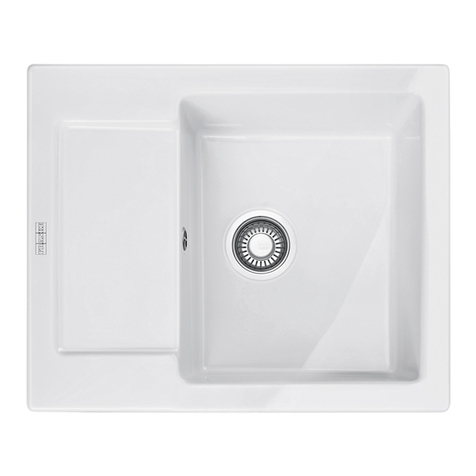
Franke
Franke MRK 611-62 User manual
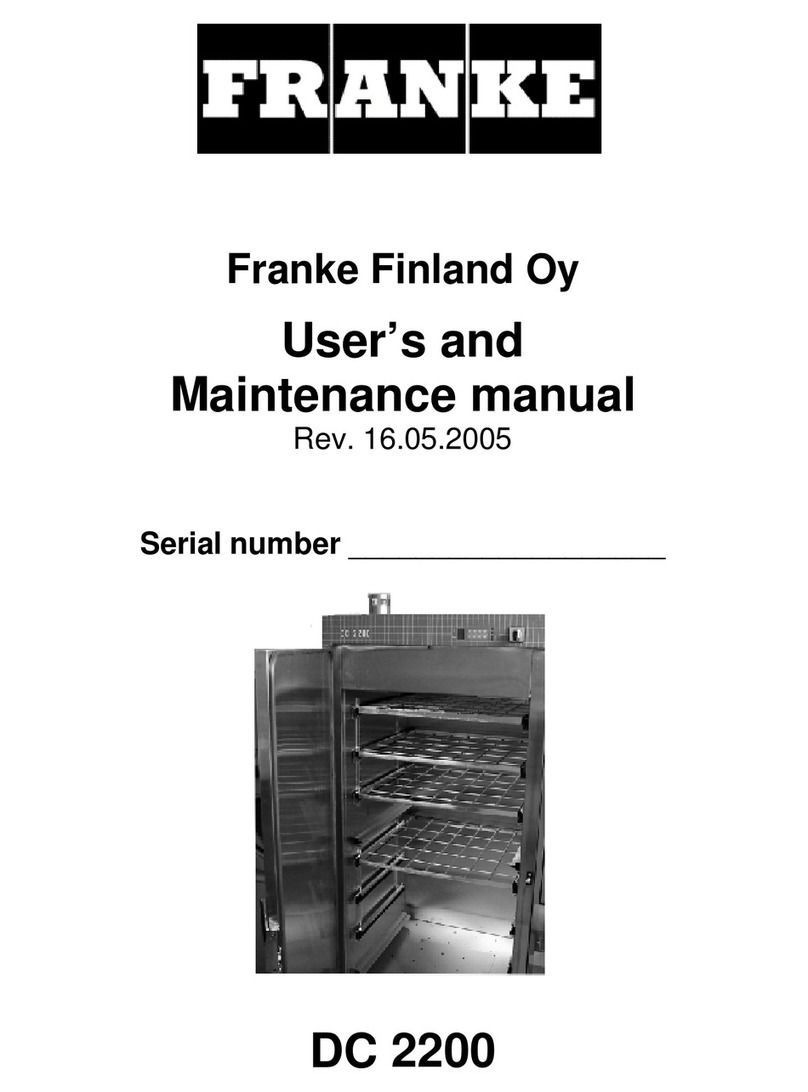
Franke
Franke DC 2200 Operating instructions
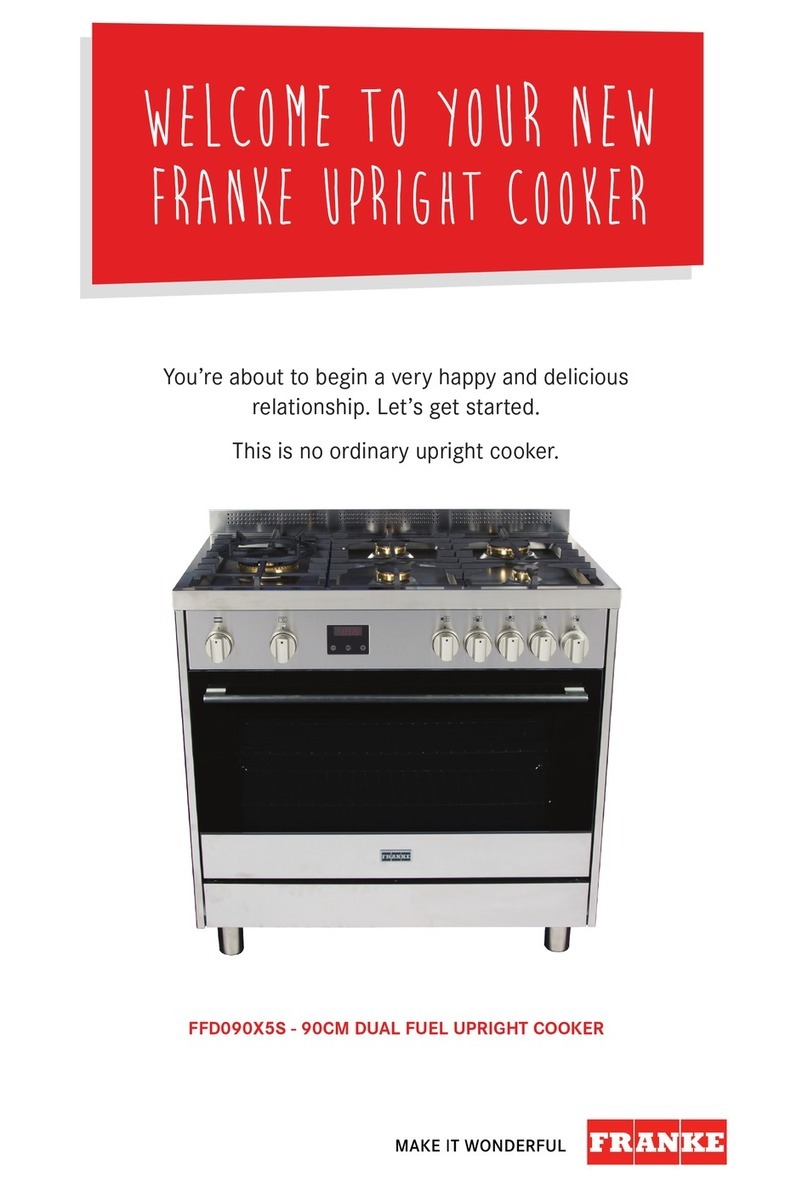
Franke
Franke FFD090X5S User manual
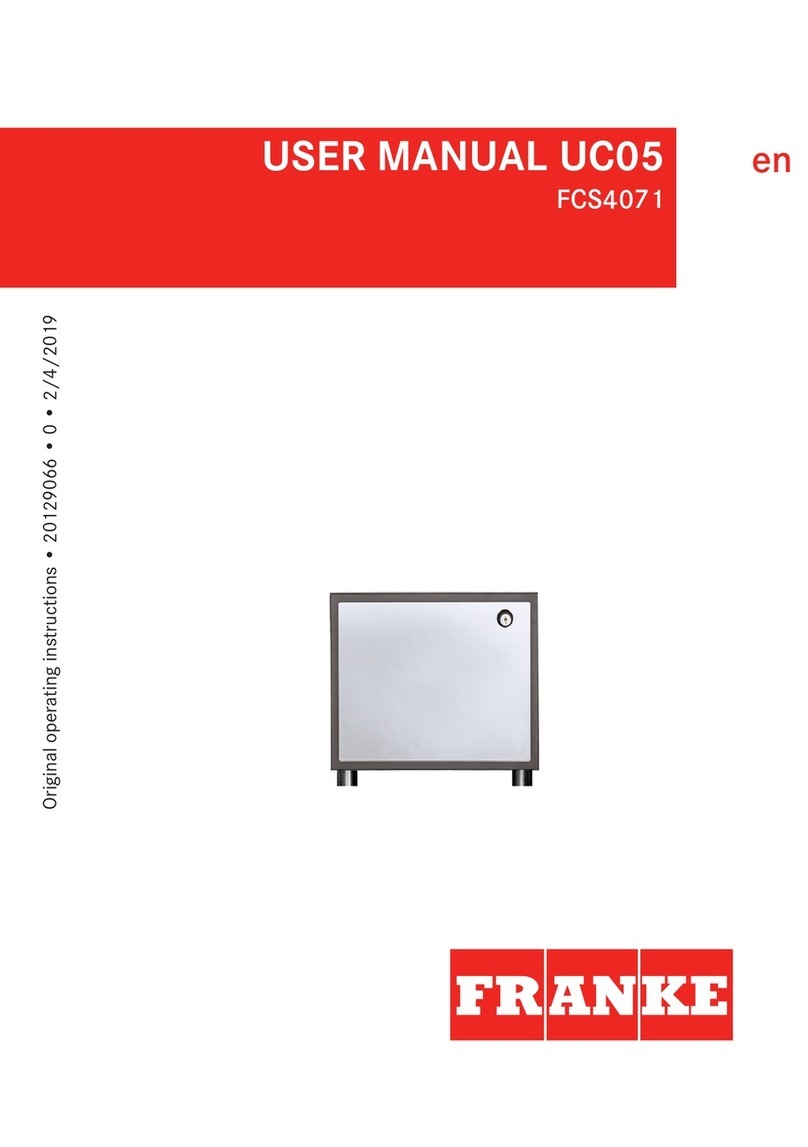
Franke
Franke FCS4071 User manual
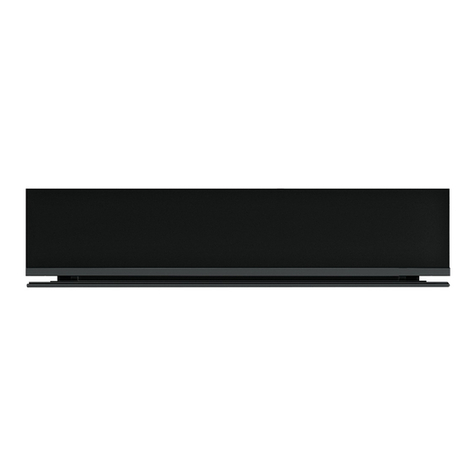
Franke
Franke FMY 14 DRW User manual
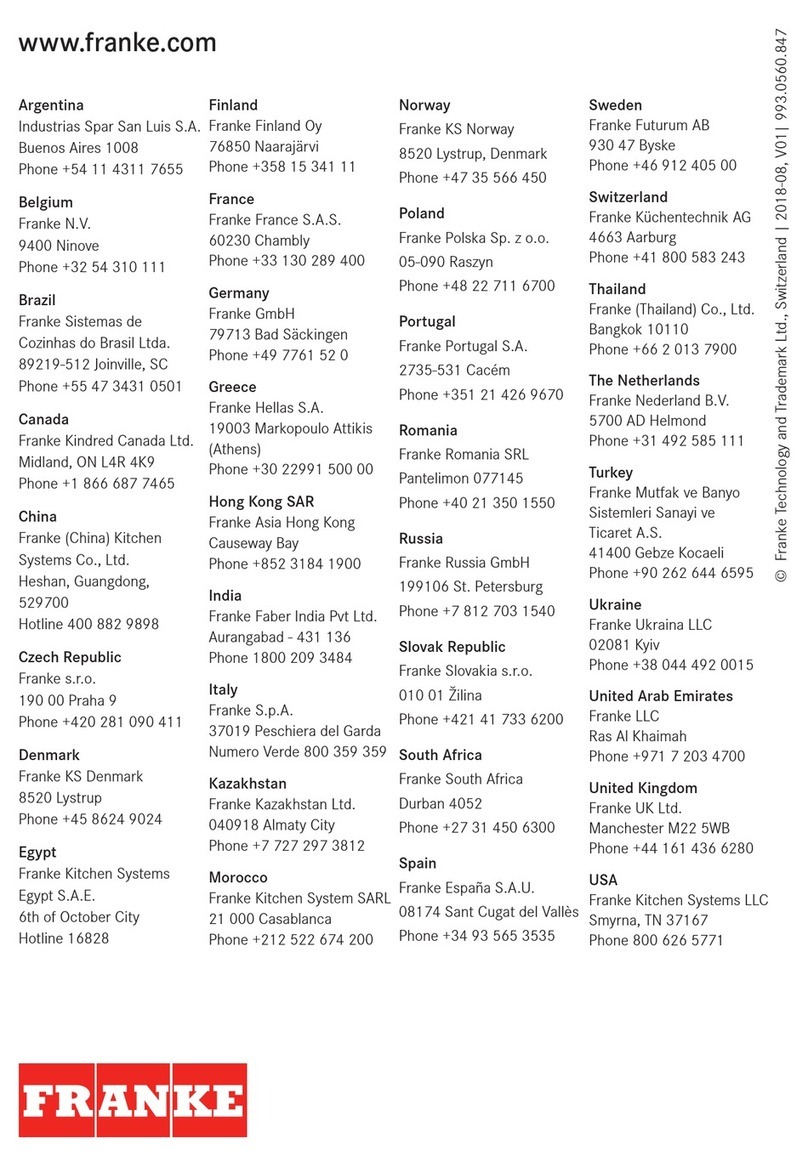
Franke
Franke KEA Liana User manual
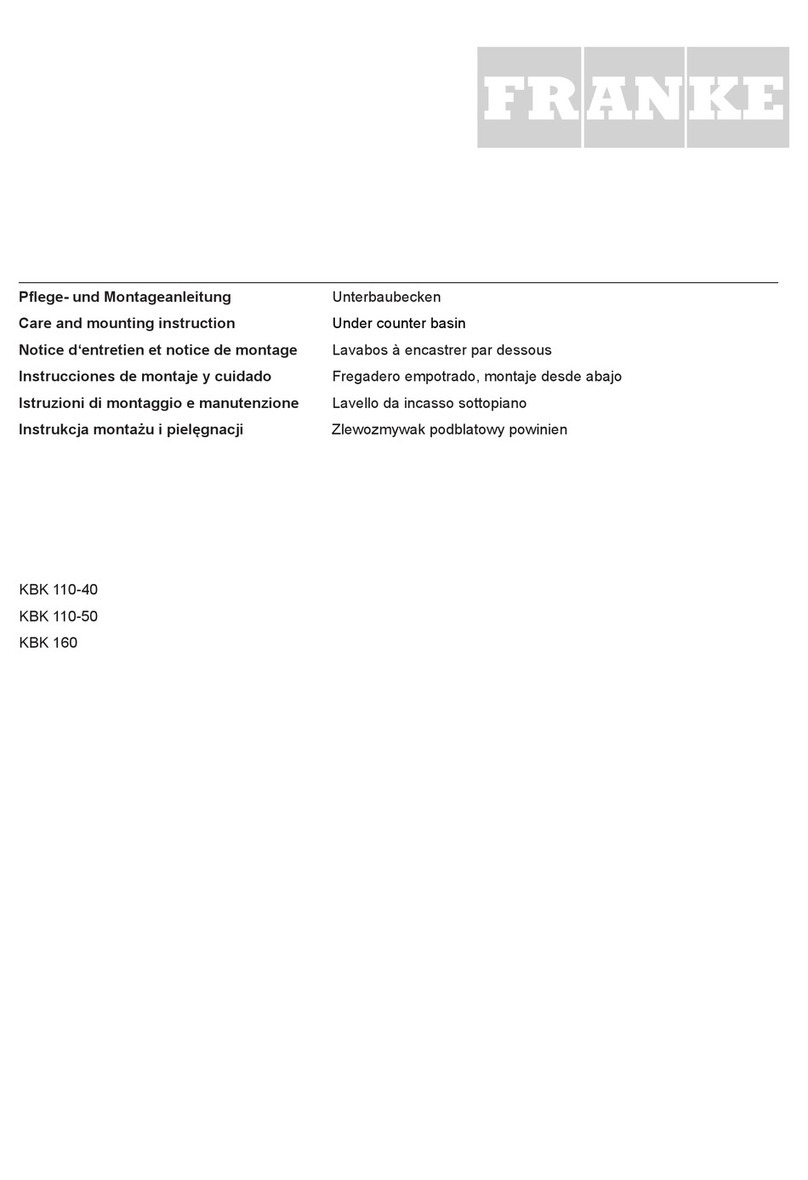
Franke
Franke KBK 110-40 User manual
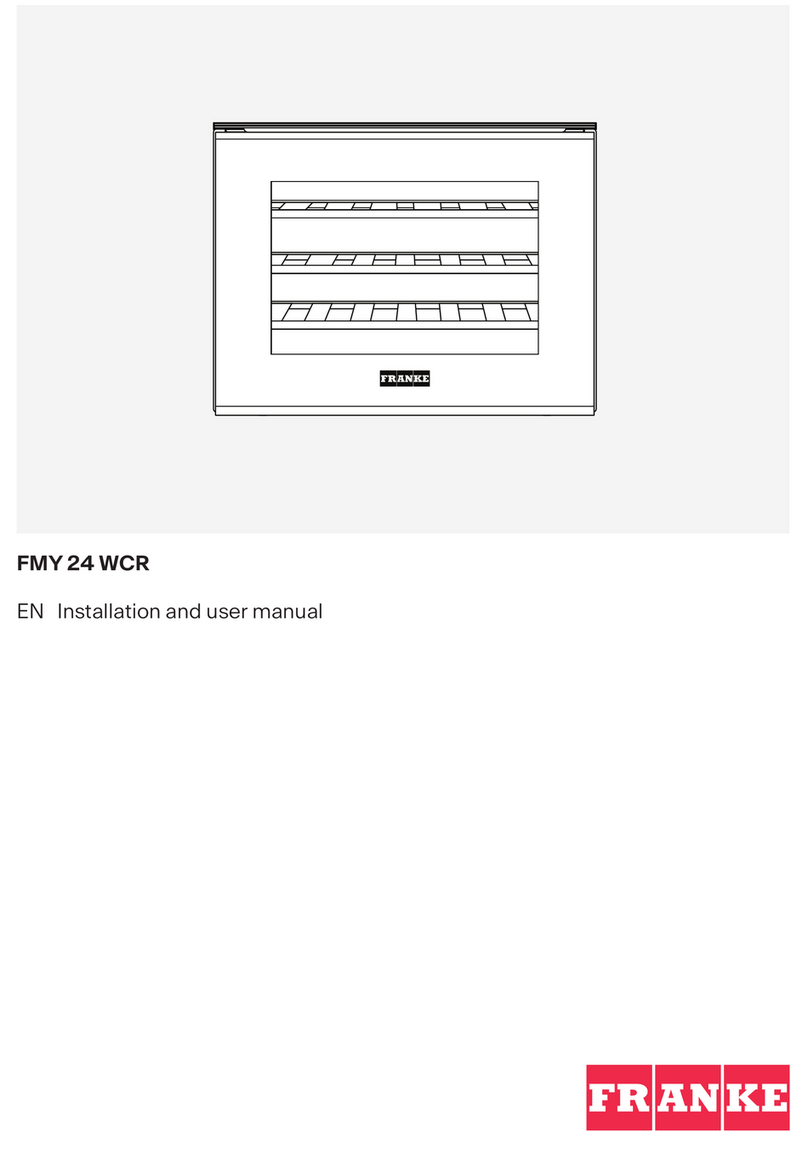
Franke
Franke FMY 24 WCR User manual
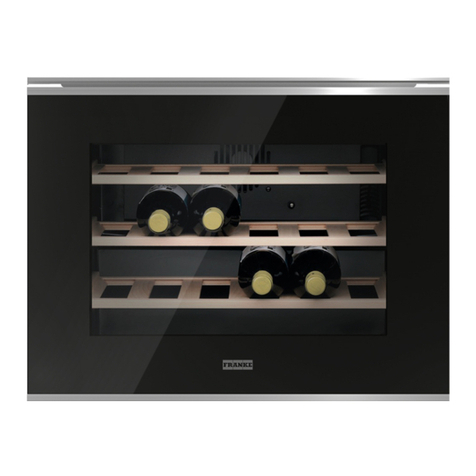
Franke
Franke FMY 24 WCR XS User manual

Franke
Franke FHCR 604 2I 1 FLEXI T PWL Instruction Manual
